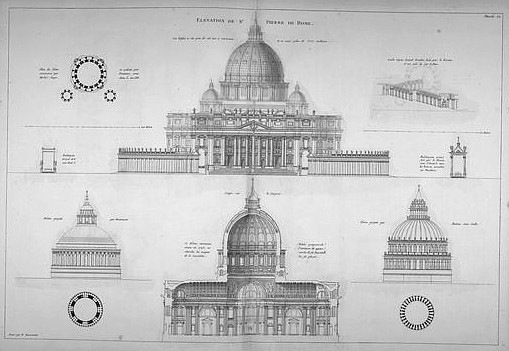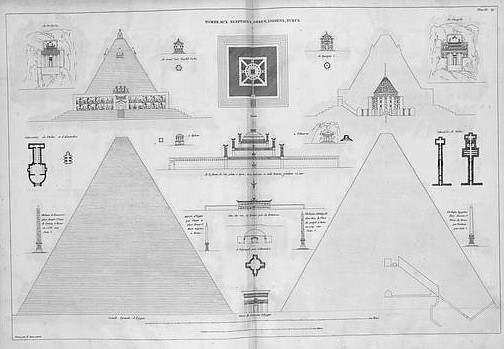2002.08.16 13:49
Re: 1000 Kunstler
Interesting how Denise Scott Brown mentions "A small church or synagogue, set within a row of town houses or surrounded by office buildings, holds its own with dignity" in her editorial/op-ed piece on development of Lower Manhattan in today's NYTimes.
2003.08.16 09:39
Re: closing the visible space
In Durand's Recueil et parallèle des édifices de tout genre, anciens & modernes, remarquables par leur beauté, par leur grandeur ou par leur singularité, 1800, where a 'history' of architecture is presented via plans and elevations all drawn at the same scale and categorized by type (ie, temples, churches, palaces, theaters, etc.), the only building/structure larger than St. Peter's Basilica is the Great Pyramid of Giza--the Great Pyramid originally reached a height of 480 ft.; St. Peter's reaches 452 ft.; the U.S Capitol reaches 287.5 ft. From this 'record', it is likely safe to say that St. Peter's is the largest hollow stone/masonry building.
| |
2003.08.16 10:35
Re: iron curtain
M., the Iron Curtain was certainly real/physical between East and West Germany. From the two Germanys, the Iron Curtain proceeded south all the way to the Adriatic Sea, ending between Trieste, Italy and Yugoslavia. A writer took a specific journey along the entire length of the Iron Curtain--before the book was published, much of it was first printed in the New Yorker (1983 or 84) in three parts (which is what I read). I seem to recall that the "fence" was mostly real and contiguous from north to south, although the severity of the 'curtain' and what it manifest and represented gradually diminished the further south it was.
I traveled (by car) through two (of the three?) checkpoints between the West and East German border in May 1990. [These checkpoints are not to be confused with the 'famous' Alpha, Bravo and Charlie Checkpoints--A and B between West Berlin and East Germany, and Charlie specifically between East and West Berlin. I went through A, B and C, plus I crossed over the Glienike Bridge between West Berlin and Potsdam--this is the bridge were spies were famously traded.] The Iron Curtain was very real at these points. This was an interesting time because the Berlin Wall was already coming down, but there were still two Germany's, thus the 'checking' at the checkpoints (for all Germans at least) was relatively lax, although the whole 'apparatus' was still in place. In fact, at my final crossing from East to West at Erfurt, the gates were just open and there were no guards anywhere to be seen.
2003.08.16 15:11
Re: pointers
There is a very good scale comparison of "shopping" places, from Trajan's Market (110 AD) to Super K-Mart (1997) within the Harvard School of Design Guide to Shopping--this is for sure a continuation of Durand's method.
2005.08.16 11:28
the agnostic design of spiritual space
I have some ideas about how to design sacred space, and they have to do with making it osmotic and electromagnetic. Some of Kahn's best architecture is osmotic and electromagnetic.
| |
07081601 Trivilla Savoye plans 2370i22
07081602 Trivilla Savoye perspectives 2385i01 b
07081603 Villa Savoye model reduced jambs 2370i23 b
07081604 Trivilla Savoye model 2385i02
07081605 Trivilla Savoye perspectives 2385i03
2009.08.16 12:01
Postmodernism sucks... discuss
...where we see Postmodern architecture related to the growing trend of realism in film (including cinematic pornography). Not exactly a parallel development, but more where realism in films opened up designers/architect's minds to a more realistic approach to designing buildings/environments. Prior to realism, most films were an adapted form of theater/stage production. Realism in film presented 'real' situations within 'real' settings. [Yes, there is the omnipresent irony of films themselves not being real to begin with.]
aside: Does anyone else remember the paparazzi catching Jackie O. after she saw I am Curious (yellow).
Outside the stage directions of the Modern Movement there is the quickly found serendipity of everyday living/experience, and this realm of no clear rules beyond the immediate context of the situation made it easy for (what Portoghesi called) 'the end of prohibitionism'.
Postmodern architecture would not have happened without a certain frame of mind, and that frame of mind was becoming more and more prevalent within films of the later 1960s and 1970s.
Strictly within architecture itself, Scully, in 'How things got to be the way they are now', finds the genesis of Postmodern architecture with Kahn and Kahn's Beaux Arts education and Roman-ness (wrapped together via Piranesi's plan of the Campo Marzio).
It seems worth noting that the two most significant architects to come out of the 'Strada Novissima' are Frank Gehry and Rem Koolhaas/OMA.
| |
2009.08.16 14:07
Postmodernism sucks... discuss
I think you have to first define what 'that' is.
Otherwise, architecture still pretty much operates within the 'realm of no clear rules beyond the immediate context of the situation'.
2009.08.16 15:44
Postmodernism sucks... discuss
Many of the architects who utilized "the application of content and forms and motifs that are deliberately identifiable in cultural and historical terms" 30 years ago still design that way today (if they are still active and/or alive).
The first Greenaway film I saw was The Draughtsman's Contract in 1983, 27 years ago, and that's the kind of murder mystery I'm talking about.
The first Tarantino film I saw was Pulp Fiction in 1994 and soon after that architecture started becoming very virtual.
2009.08.16 18:06
Postmodernism sucks... discuss
Of course architecture and film evolve for the most part independently, as I already referenced Scully and Kahn above.
The relation between film and postmodern architecture I'm here discussing is not one where the architecture emulates the films, rather architects took on the 'realist' frame of mind of 60s and 70s films, again where there are no clear rules beyond the immediate context of the situation.
Architecture today is still very eclectic, diverse even, and, perhaps more now that ever, there are no clear rules beyond the immediate context of the situation.
| |
2009.08.16 12:42
hence creative ingenuity
creative: the vast majority of more recent residential architecture.
ingenutiy: the more recent residential projects of Koolhaas/OMA.
14081601 BIG The Big U - Rebuild by Design New York City
14081602 Carme Pinós CaixaForum Zaragoza
15081601 Parkway Interpolation Philadelphia true north 4400x8800 site plan 3392ui43
15081602 Parkway Interpolation Philadelphia true north 4400x8800 site plan full street grid 3392ui44
17081601 surface models work 2462i12
17081602 Porticus Neroniani skeleton circle/square juncture diagram 2393i12
17081603 Ottopia skeleton plans 2349i06
18081601 Eclectic Houses Early Renaissance model work 223ai16
18081602 Eclectic Houses Palladian model work 223ai17
18081603 Eclectic Houses Furnessesque model work 223ai18
19081601 iq14 Philadelphia street map overlay 2093i100
19081602 iq18 Philadelphia street map overlay 2093i101
19081603 iq22 Philadelphia street map overlay 2093i102
19081604 iq26 Philadelphia street map overlay 2093i103
19081605 diptych plans 2197i20
19081606 museum collecting Hadrian's Villa Farnsworth House Glass House Eames House Painting Gallery Sculpture Gallery Pond Pavilion Library Maison de l'Homme House 10: Museum Wall House 2 Atheneum plans site plan 2171i07
|

